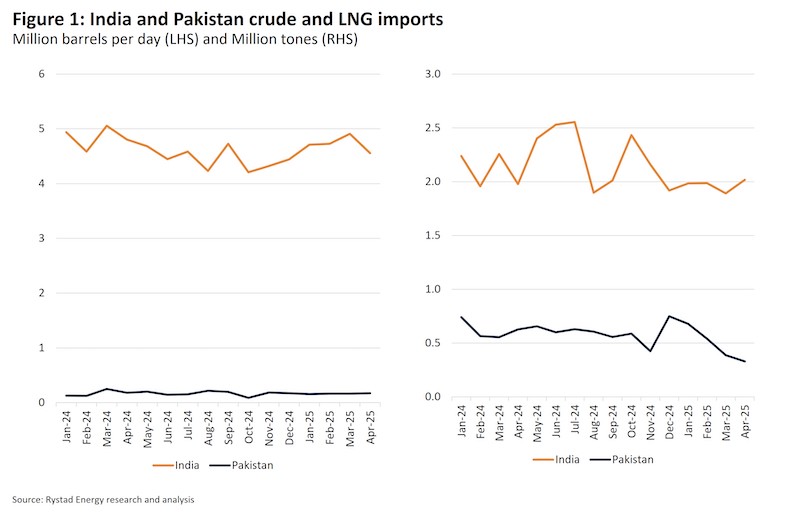

By K Ravendran
Reports from across the border suggest that Pakistan is already experiencing a fuel crisis, whereby gas pumps are closed for the time being. An analysis of the emerging energy scenario in the aftermath of the current conflict suggests the start of a serious crisis for Pakistan, while India Relativley is in a much better position to cope with any situation.
The flare -up of tensions has also raised the importance of emergency prepareness in the energy sector, because a long -term conflict would seriously influence the ability of both countries to meet the energy needs, according to analysts with the Rystad Energy.
In terms of daily rough question, India consumes 5.40 million barrels per day (BPD) compared to the 0.25 million BPD from Pakistan, according to estimates. However, the discrepancy goes beyond the demand – the strategic and commercial reserve of India can maintain the offer for more than a month, while Pakistan, which is not missing strategic rewindings, is worth only 20 days in stock.
If tensions apart, Bush -countries expect that they will increase raw persecution and refinery activity.
The demand of the diesel is likely to rise in the midst of increased military mobilization, while the fuel consumption of airlines decreases as the airspace closures lead to crumbled flights, cancellations and rising aviation ticket pries.
By comparing their strategic petroleum reserves, a considerable Tripity – India you have a strategic reserve capacity of 39 million barrels, with currently available 21.4 million barrels. Pakistan, on the other hand, has no strategic reserves, which may disrupt the vulnerable nation in the offer.
This gives India the coverage of approximately seven days, based on the existing strategic reserves.
In addition, the commercial stocks of India of nearly 160 million barrels can replace the country with around 33 SEYs, while the stocks of Pakistan last 20 days.
While India’s crude oil supply obligations are managed, this is mandatory by the oil and gas -regulating authority (OGRA).
As the global rough importer of the third alcude, the dependence on India is in import of India, with 85 percent of his requirement that is met that import. Pakistan, also, heavily on input, who meets around 78 percent of his requirement.
Refineries on both sides are away from the conflict area and the drawing lines of an impact on refinery operations remain. Although the absence of refineries and LNG terminals in the Affeded regions may not have an influence on the import of crude oil and LNG, the Tirence in emergency parateness between India and Pakistan is a reason for concern.
The risk of direct attacks on commercial ships is rare and prohibited according to international law. Nevertheless, in times of increased tension, the risk of military confrontations or misunderstanding, especially in areas near Marine operations. Tankers that pass on the region can be subjected to control or mundition if the situation climbs.
The most important refining hubs of India in western Gujarat treat more than 50 percent of the daily rough import of the country, with the ports supply Sikka, Vadinar and Mundra six refineries. In the next five days, five rough degree of crude oil will arrive from the middle – two already in Indian waters, with the other three with more than 5 million barrels of Arabic Light and Basrah Heavy are on a route.
According to analysts, the suspension of the Indus water treaty is a serious risk of energy breach for Pakistan, with a maximum of 9.3 GW water power capacity – or 90% of the total – in danger as a result of undeveloped water flows from India.
Analysts are of the opinion that the termination of the India Convention on the Indus, Jhelum and Chenab rivers would give, so that it can build more hydropower projects and possibly control existing electric facilities in ways that can influence his electric neighbor.
Although India is less dependent on hydropower, further escalation can still endanger its energy infrastructure. India has 2.7 Gigawatt (GW) of hydropower projects that depend on the rivers built in the IWT from a total of 52 GW installation of the installation of the installation of the hydropower throughout the country.
The biggest project in danger is the 900 Megawatt (MW) Bagilhar dam with intake of the Chenab. Disruption of these projects will have a relativley small impact, because in 2024 hydropower contributed only 8% to the total power generation.
On the other hand, any further escalation in the tensions between India and Pakistan can have an energy infrastructure, nuclear including power plants in both countries, with a greater risk of becoming military goals. Rystad Energy Analysis indicates that disruption of the IWT up to 9.3 GW can produce hydropower capacity – equal to 90% of the total installation of Pakistan in the risk. The largest hydroelpiece project that runs risk is the 4.9-GW Tarbela dam with inflow of the Indus. (IPA -Service)


